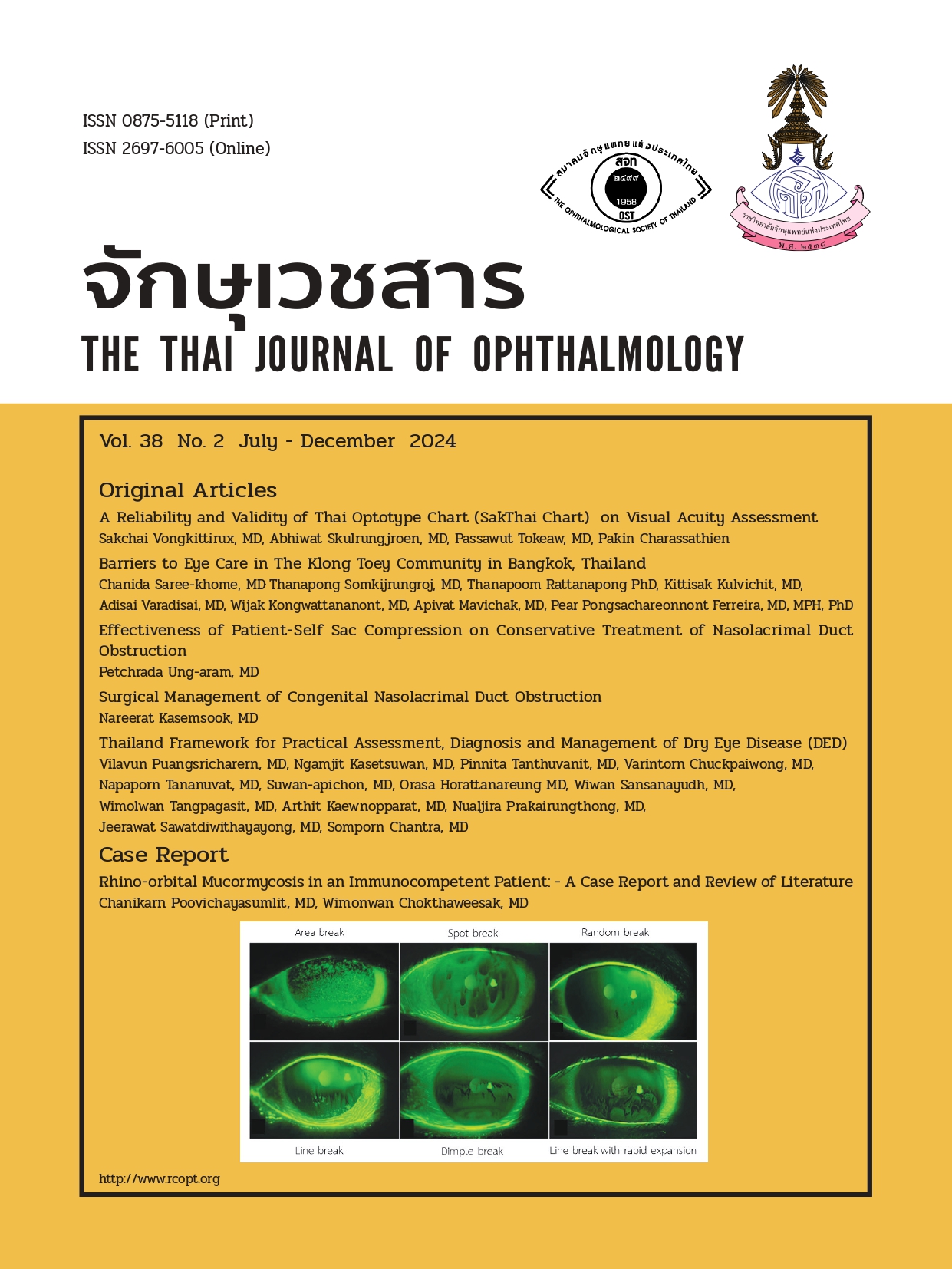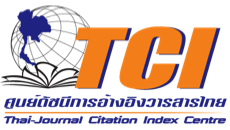surgical management of congenital nasolacrimal duct obstruction
Abstract
หลักการและเหตุผล: โรคท่อน้ำตาอุดตันแต่กำเนิดในเด็ก เป็นภาวะน้ำตาเอ่อที่พบบ่อยที่สุดในเด็ก โดยเด็กอายุน้อยกว่า 13เดือน ควรให้การรักษาตามอาการ นวดถุงน้ำตา ให้ยาปฏิชีวนะกรณีติดเชื้อ พบในเด็กเล็กมีอัตราการหายเองสูงมาก กรณีเด็กอายุมากกว่า 13เดือน อัตราการหายเองต่ำ ควรทำการผ่าตัด เช่น การแยงท่อน้ำตา การแยงท่อน้ำตาร่วมกับการใส่สายซิลิโคน การแยงท่อน้ำตาร่วมกับการใส่บอลลูนขยาย และการผ่าตัดเชื่อมถุงน้ำตากับโพรงจมูก
วัตถุประสงค์: ศึกษาผลสำเร็จของการผ่าตัดในผู้ป่วยท่อน้ำตาอุดตันในเด็ก
รูปแบบการวิจัย: การศึกษาแบบเชิงพรรณนาย้อนหลัง
วิธีการศึกษา: รวบรวมบันทึกเวชระเบียนผู้ป่วยท่อน้ำตาอุดตันในเด็ก อายุ 0-10ปี ที่เข้ารับการรักษาที่โรงพยาบาลมหาราชนครราชสีมา ตั้งแต่วันที่ 1 มกราคม พ.ศ. 2554 ถึงวันที่ 31 ธันวาคม พ.ศ. 2564 (รวม 11ปี) โดยเก็บข้อมูล เพศ อายุ ข้าง และวิธีการผ่าตัด วิจัยนี้ศึกษาการผ่าตัดในจักษุแพทย์ท่านเดียวที่ทำการวิจัย เก็บข้อมูลการติดตามการรักษา และภาวะแทรกซ้อน
ผลการศึกษา: เด็กท่อน้ำตาอุดตันทั้งหมด 35คน แบบกลุ่มตามวิธีผ่าตัด เป็นสามกลุ่มคือ กลุ่มแรกแยงท่อน้ำตาอย่างเดียวทำในกรณีที่ล้างท่อน้ำตาลงคอหลังแยงท่อน้ำตาในห้องผ่าตัด พบ 12คน(17ตา) อายุเฉลี่ย 23.9เดือน อัตราสำเร็จการผ่าตัด100% กลุ่มที่สอง ผ่าตัดแยงท่อน้ำตาร่วมกับใส่สายซิลิโคน ในกรณีที่ล้างท่อน้ำตาไม่ลงคอหลังแยงท่อน้ำตาในห้องผ่าตัด (มีความซับซ้อนของโรคมากกว่ากลุ่มแรก) พบ 20คน (26ตา) อายุเฉลี่ย 43.4เดือน อัตราสำเร็จการผ่าตัด 92.3% กลุ่มที่สาม ผ่าตัดเชื่อมถุงน้ำตากับโพรงจมูกในเด็กอายุมากกว่า 5ปี พบ 4คน (4ตา) อายุเฉลี่ย 83 เดือน อัตราสำเร็จการผ่าตัด 75% พบภาวะแทรกซ้อนเฉพาะในกลุ่มเด็กที่ผ่าตัดแบบใส่สายซิลิโคน คือ เลือดออกจมูก 1คน (1ตา) และสายหลุดก่อนกำหนด 4คน (7ตา)
สรุป: กลุ่มเด็กท่อน้ำตาอุดตันที่อายุเกินกว่า 13เดือน ควรได้รับการรักษาอย่างฉับไว เนื่องจากอายุมีผลต่ออัตราความสำเร็จของการแยงท่อน้ำตา การเลือกวิธีการผ่าตัดที่เหมาะสมตั้งแต่ครั้งแรกของการผ่าตัด เช่น การแยงท่อน้ำตาร่วมกับการใส่สายซิลิโคนในกลุ่มเด็กที่มีความซับซ้อน หรือการผ่าตัดเชื่อมถุงน้ำตากับโพรงจมูกในเด็กอายุมากกว่า 5ปี ให้ผลการรักษาที่ดี แต่อย่างไรก็ดีกลุ่มผู้ป่วยท่อน้ำตาอุดตันที่ไม่ซับซ้อน การผ่าตัดด้วยการแยงท่อน้ำตาอย่างเดียวอัตราความสำเร็จสูงกว่าในกลุ่มท่อน้ำตาอุดตันที่มีความซับซ้อน
References
Takahashi Y, Kakizaki H, Chan WO, Selva D. Management of congenital nasolacrimal duct obstruction. Acta Ophthalmologica. 2010 Aug;88(5):506-13.
Milder B, Weil BA. The lacrimal system. Norwalk(CN): Appleton-Century-Crofts A publishing division of Prentice-Hall, Inc.;1983. p. 95-104.
Weber RK, Keer lR, Schaefer SD, Rocca RCD. Atlas of lacrimal surgery. Heidelberg: Springer; 2007.p. 53-60.
Al-Faky YH. Nasal endoscopy in the management of congenital nasolacrimal duct obstruction. Saudi J Ophthalmol. 2014 Jan;28(1):6-11.
Heichel J, Bredehorn-Mayr T, Struck HG. Congenital nasolacrimal duct obstruction from an ophthalmologist’s point of view: causes, diagnosis and staged therapeutic concept. HNO 2016; 64:367 – 375.
Kashkouli MB, Kassaee A, Tabatabaee Z. Initial nasolacrimal duct probing in children under age 5: cure rate and factors affecting success. J AAPOS 2002; 6:360 – 363.
Repka MX. Timing of simple probing for congenital nasolacrimal duct ob- struction: not so simple. JAMA Ophthalmol 2018; 136:1286 – 1287.
Baker JD. Treatment of congenital nasolacrimal system obstruction. J Pediatr Ophthalmol Strabismus 1985; 22:34 – 36.
Katowitz JA, Welsh MG. Timing of initial probing and irrigation in congenital nasolacrimal duct obstruction. Ophthalmology 1987; 94:698 – 705.
Vagge A, Ferro Desideri L, Nucci P, Serafino M, Giannaccare G, Lembo A, Traverso CE. Congenital Nasolacrimal Duct Obstruction (CNLDO): A Review. Diseases. 2018 Oct 22;6(4):96.
Kashkouli MB, Beigi B, Parvaresh MM, et al. Late and very late initial probing for congenital nasolacrimal duct obstruction: what is the cause of failure? Br J Ophthalmol 2003; 87:1151 – 1153.
Kashkouli MB, Karimi N, Khademi B. Surgical management of congenital nasolacrimal duct obstruction; one procedure for all versus all procedures for one. Curr Opin Ophthalmol. 2019 Sep;30(5):364-371.
Ali MJ, Kamal S, Gupta A, et al. Simple vs complex congenital nasolacrimal & duct obstructions: etiology, management and outcomes. Int Forum Allergy Rhinol 2015; 5:174–177.
Eshraghi B, Khalilipour E, Ameli K, et al. Pushed monocanalicular intubation versus probing for the treatment of simple and incomplete complex types of congenital nasolacrimal duct obstruction in children older than 18 months old. Orbit 2017; 36:218–222.
Khatib L, Nazemzadeh M, Revere K, et al. Use of the Masterka for complex nasolacrimal duct obstruction in children. J AAPOS 2017; 21:380–383.
Maheshwari R. Balloon catheter dilation for complex congenital nasolacrimal duct obstruction in older children. J Pediatr Ophthalmol Strabismus 2009; 46:215 – 217.
Downloads
Published
Issue
Section
License
Copyright (c) 2025 The THAI Journal of OPHTHALMOLOGY

This work is licensed under a Creative Commons Attribution-NonCommercial-NoDerivatives 4.0 International License.
The Thai Journal of Ophthalmology (TJO) is a peer-reviewed, scientific journal published biannually for the Royal College of Ophthalmologists of Thailand. The objectives of the journal is to provide up to date scientific knowledge in the field of ophthalmology, provide ophthalmologists with continuing education, promote cooperation, and sharing of opinion among readers.
The copyright of the published article belongs to the Thai Journal of Ophthalmology. However the content, ideas and the opinions in the article are from the author(s). The editorial board does not have to agree with the authors’ ideas and opinions.
The authors or readers may contact the editorial board via email at admin@rcopt.org.


